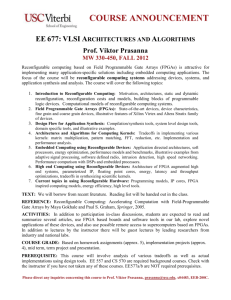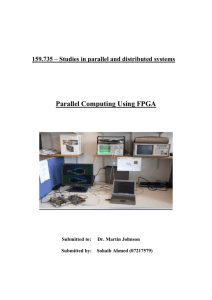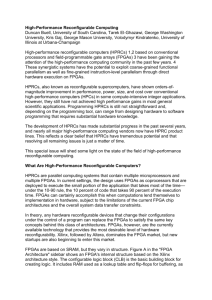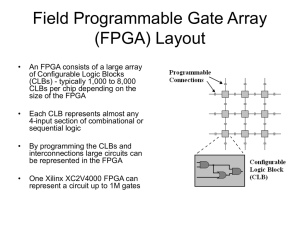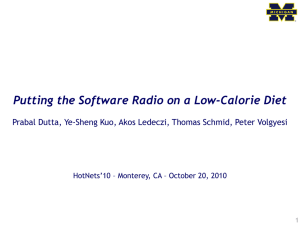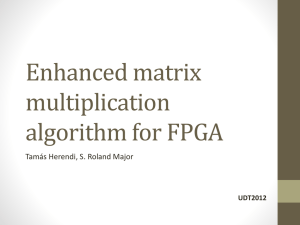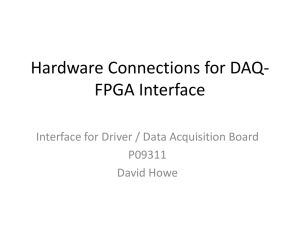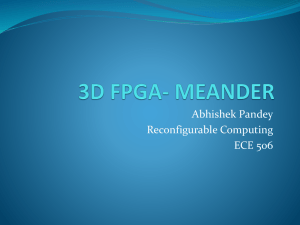part1
advertisement
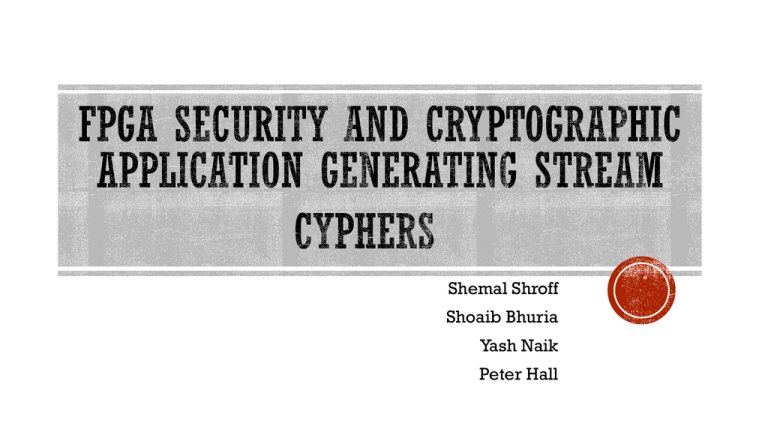
Shemal Shroff Shoaib Bhuria Yash Naik Peter Hall Introduction to Security Relevance to FPGA Design and Manufacture flow for an FPGA Things to secure and why? Types of Attack Prevention PUFs Provisions and policies adopted by a network administrator To prevent and monitor: Unauthorized access, Misuse, Modification, Denial of a computer network and network-accessible resources. Simmonds, A; Sandilands, P; van Ekert, L (2004). "An Ontology for Network Security Attacks". Lecture Notes in Computer Science. Lecture Notes in Computer Science 3285: 317–323 Research on “FPGA Security” has been active since the early 2000s. Several commercial and military applications employ programmable logic. This makes design security important for safety and national security. WP365, Solving Today’s Design Security Concerns, Xilinx White Paper. To learn the confidential cryptographic key. One-to-one copy or “cloning” together with its key. Reverse engineering of encryption algorithm. Execute certain cryptographic operation with presumably secret key. E.g. pay-tv and in-government communications Thomas Wollinger and Christoff Paar, Security Aspects of FPGAs in Cryptographic Applications in New Algorithms, Architectures and Applications for Reconfigurable Computing, Springer, 2005, Ch. 21, pp 265-278. Saar Drimer, Volatile FPGA Design Security – A Survey, v0.96, April 2008. Figure: Simplified depiction of the FPGA design, manufacturing, packaging, and testing processes. Saar Drimer, Volatile FPGA Design Security – A Survey, v0.96, April 2008. Figure: Development, manufacturing, and distribution of an FPGA-based system. Saar Drimer, Volatile FPGA Design Security – A Survey, v0.96, April 2008. B. Dipert. Cunning circuits confound crooks. http://www.e-insite.net/ednmag/contents/images/21df2.pdf, October 12 2000. Bitstream Configuration of the device Bitstream has all the configuration bits required for programming the FPGA. If the bitstream is compromised then your design can be cloned or reverse engineered. To protect the logic of FPGA To prevent manipulation of design using JTAG. Single Event Upset (SEU) or faults Verify that the application is trusted to be correct. Authenticate the application. Black box Attack Reverse engineering Bitstream Cloning of sRAM FPGAs Readback Attack Side Channel Attack Attacks Fault injection Hardware virus Configuration of the device Manipulating design through JTAG Voltage modification Temperature 1. Black Box Attack 2. Reverse-Engineering of the Bitstreams 3. Cloning of sRAM FPGAs 4. Readback Attack 5. Side Channel Attacks Step 1: The attacker inputs all possible combinations, while saving the corresponding outputs. Step 2: Develops a K-map to simplify the resulting tables Step 3: Extracts the logic of the FPGA. Thomas Wollinger and Christoff Paar, Security Aspects of FPGAs in Cryptographic Applications in New Algorithms, Architectures and Applications for Reconfigurable Computing, Springer, 2005, Ch. 21, pp 265-278. A C AB 00 01 11 10 B C Output (Y) 0 0 0 0 0 0 1 0 0 0 1 0 0 0 1 0 1 1 0 0 0 0 0 1 1 0 1 0 0 0 1 0 1 0 1 1 0 0 1 1 1 0 Y = (A.B)’.B.C’ = A’BC’ Not a real threat nowadays, due to: complexity of the designs size of state-of-the-art FPGAs. Common I/O pins which makes it difficult to connect to the right pin. An attacker has to connect to device’s pin of a known function like, Microprocessor interrupt input, And also, Figure out whether to: Drive a pin with a voltage, Sense its output state, or both isn’t a straightforward exercise. B. Dipert. Cunning circuits confound crooks. http://www.e-insite.net/ednmag/contents/images/21df2.pdf, October 12 2000. Thomas Wollinger and Christoff Paar, Security Aspects of FPGAs in Cryptographic Applications in New Algorithms, Architectures and Applications for Reconfigurable Computing, Springer, 2005, Ch. 21, pp 265-278. A = 32 bits B = 32 bits Adder Output We have, in total, 264 input combinations. Lets assume that latency for the adder is 10 ns. Therefore, time to apply all the combinations is 264 x10 ns. This takes approximately 5849 years which is equivalent to 5.849 x 1011 hours. Reconstructing the original circuit details Altering the design Incorporating it in other designs Reverse Engineering Saar Drimer, Volatile FPGA Design Security – A Survey, v0.96, April 2008. Thomas Wollinger and Christoff Paar, Security Aspects of FPGAs in Cryptographic Applications in New Algorithms, Architectures and Applications for Reconfigurable Computing, Springer, 2005, Ch. 21, pp 265-278. These are the toughest to crack.Why? Increase in gate counts w.r.t number of I/O pins Antifuse Encryption PUFs B. Dipert. Cunning circuits confound crooks. http://www.einsite.net/ednmag/contents/images/21df2.pdf, October 12 2000. Security implications of storing data unprotected and external to FPGA Non-volatile memory Transmitted during power up Vulnerability = can be easily eavesdropped Feasible Thomas Wollinger and Christoff Paar, Security Aspects of FPGAs in Cryptographic Applications in New Algorithms, Architectures and Applications for Reconfigurable Computing, Springer, 2005, Ch. 21, pp 265-278. Non-volatile + FPGA on one chip Battery-Backed RAM eFUSE Device DNA Encryption PUFs Thomas Wollinger and Christoff Paar, Security Aspects of FPGAs in Cryptographic Applications in New Algorithms, Architectures and Applications for Reconfigurable Computing, Springer, 2005, Ch. 21, pp 265-278. Battery-Backed RAM 256-bit key stored in volatile on-chip memory cells. Must receive continuous power from the external battery. eFUSE securely store bitstream decryption key. No BB-RAM and external battery. The OTP eFUSE links are permanently programmed. No need battery backup. Device DNA Virtex-6 has embedded, unique device identifier (Device DNA). unique 57-bit identifier is nonvolatile and permanently programmed Present in all FPGAs. For easy debugging. Read the configuration of FPGA through JTAG. Thomas Wollinger and Christoff Paar, Security Aspects of FPGAs in Cryptographic Applications in New Algorithms, Architectures and Applications for Reconfigurable Computing, Springer, 2005, Ch. 21, pp 265-278. A security bit can be used to prevent the readback functionality. Although, fault injection has proven successful to overcome these countermeasures in FPGA. PUFs side channel can leak important information. Side channel can be: power consumption Light Electromagnetic radiation. Power analysis of bitstream A. Bogdanov, A. Moradi et. Al, efficient and side-channel resistant authenticated encryption of FPGA Bitstreams, International Conference on Reconfigurable computing and FPGAs, 2012. Thomas Wollinger and Christoff Paar, Security Aspects of FPGAs in Cryptographic Applications in New Algorithms, Architectures and Applications for Reconfigurable Computing, Springer, 2005, Ch. 21, pp 265-278. Magnetic field surrounding FPGA Loop antenna to pick variations of field 160 bit EC point Multiplication Prior info of Encryption is must Power trace from an RSA operation Uses standard square and multiply Square and multiply operations have visibly different power profiles ‘1’ relates to squaring step followed by a multiplication step ‘0’ in the exponent involves only a squaring step CMOS transistors emit photons. Electrons gain energy when current flows. Emission energy is much higher for transition 0->1 than 1->0 To observe the light emitted, the chip needs to be opened either from its backside or front side, depending on its package type. Photons collected by high sensitivity photon sensor. InGaAs detectors have best quantum efficiency. J.Di. Battista, J. Courrege, B. Rouzeyre, L. Torres and P. Perdu, “When Failure Analysis meets Side-Channel Attacks”, CHES 2010, IACR, Santa Barbara, California, USA. First the light emission activity is localized by turning the cryptoprocessor is on/off. It is not necessary to know either the architecture of the algorithm, or its implementation. This technique is now less used because of the increasing number of metal layers which act as a light screen. There are two kinds of countermeasures: Hardware and software Software countermeasures refer to algorithmic changes, such as masking of secret keys with random values, which are also applicable to implementations in custom hardware or FPGA. More Complex Algorithms Hardware countermeasures often deal either with some form of power trace smoothing or with transistor-level changes of the logic. This technique is now less used because of the increasing number of metal layers which act as a light screen. Thomas Wollinger and Christoff Paar, Security Aspects of FPGAs in Cryptographic Applications in New Algorithms, Architectures and Applications for Reconfigurable Computing, Springer, 2005, Ch. 21, pp 265-278. Temperature Modification Voltage Modification Fault Injection/Single Event Upsets Hardware Virus Manipulating design through JTAG Modify operating voltages or temperatures of FPGA. Causes unintended behavior. Can be used to extract data or bypass certain security features. Monitor and correctly respond to fluctuations in the operating temperature and voltage. Virtex-6 FPGA System Monitor (SYSMON) CRC circuitry Zeroization of Device Thomas Wollinger and Christoff Paar, Security Aspects of FPGAs in Cryptographic Applications in New Algorithms, Architectures and Applications for Reconfigurable Computing, Springer, 2005, Ch. 21, pp 265-278. Hardware virus or a hardware Trojan Kill switch Manipulating the design through JTAG Disable write feature in JTAG Don’t download untrusted designs. Physical entity easy to manufacture but difficult to clone. PUFs implement a challenge-response authentication. Unpredictable response. This is because of the physical factors. PUFs generate different outputs for same inputs. Also, they can generate same outputs for different inputs. This randomness is due to the Challenge-Response Pairs. Ideal for cryptographic applications Arbiter PUFs Based on MUXes and Arbiter Ring Oscillator or RO-PUF Based on Delay Circuit and Counters Note: RO PUFs are more suitable for ASICs and FPGAs. Therefore, we will concentrate on it. Consists of N oscillators circuits. Each Oscillator has a unique frequency. At any instance two oscillators are picked by the MUXes. Every counter will counter number of cycles. Output will be 0 or 1 depending on counter values. Sensitive to temperature variations Limited number of Outputs Limited number of Challenge Response Pairs PUFs used to store memory (sRAMs) are the vulnerable to attacks because, They are not Manufacturer Resistant Nature of Response Controlled In IEEE HOST 2013, an sRAM PUF was cloned to generate an identical response to a same input. The attackers used a “Focused Ion Beam Circuit Edit” for the same.
